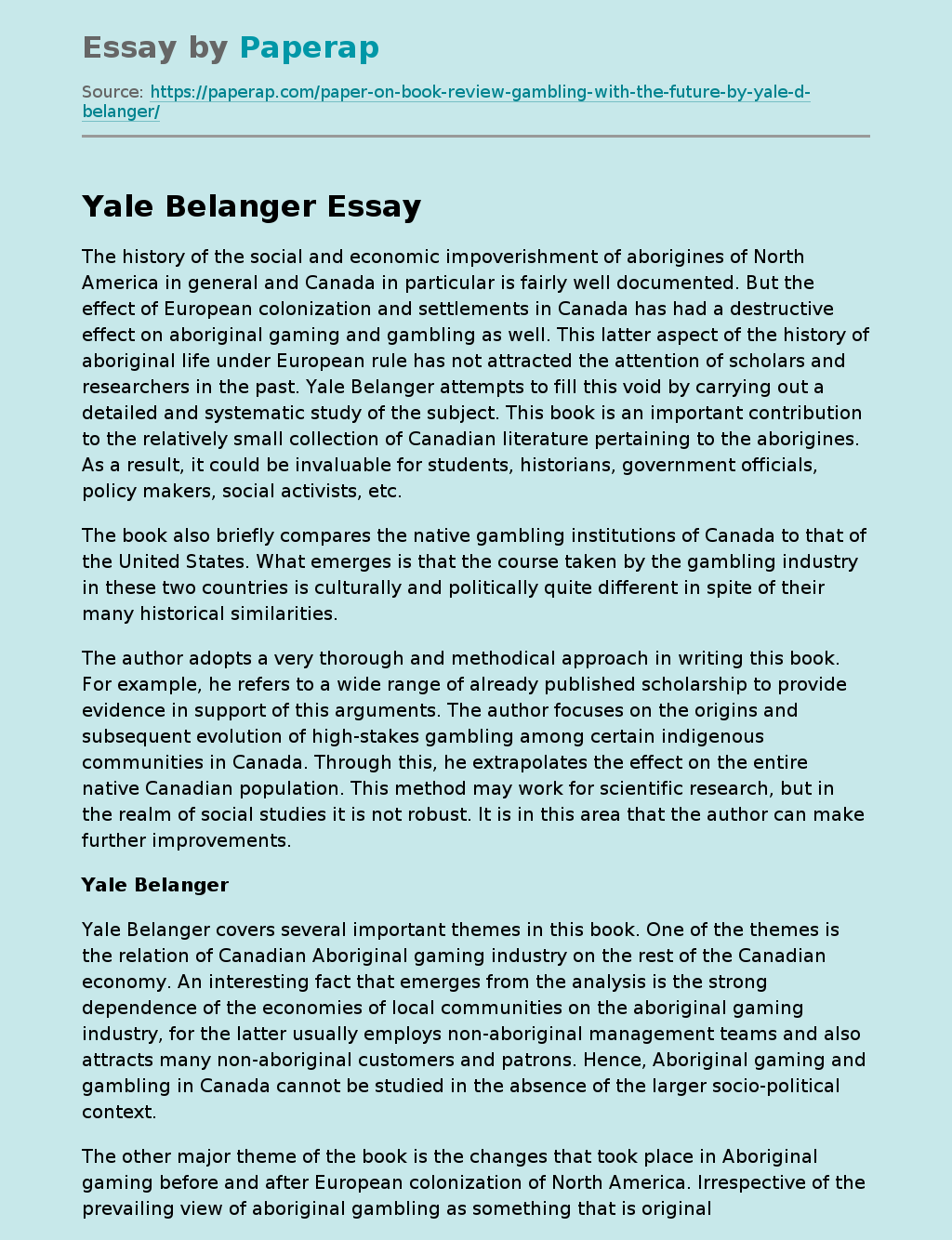Gambling With the Future
The following example essay on “Gambling With the Future” is an analysis of a literary work by Purich Publishing. The book briefly compares the native gambling institutions of Canada to that of the United States.
The history of the social and economic impoverishment of aborigines of North America in general and Canada in particular is fairly well documented. But the effect of European colonization and settlements in Canada has had a destructive effect on aboriginal gaming and gambling as well. This latter aspect of the history of aboriginal life under European rule has not attracted the attention of scholars and researchers in the past.
Yale Belanger attempts to fill this void by carrying out a detailed and systematic study of the subject. This book is an important contribution to the relatively small collection of Canadian literature pertaining to the aborigines. As a result, it could be invaluable for students, historians, government officials, policy makers, social activists, etc. What emerges is that the course taken by the gambling industry in these two countries is culturally and politically quite different in spite of their many historical similarities.
The author adopts a very thorough and methodical approach in writing this book. For example, he refers to a wide range of already published scholarship to provide evidence in support of this arguments. The author focuses on the origins and subsequent evolution of high-stakes gambling among certain indigenous communities in Canada. Through this, he extrapolates the effect on the entire native Canadian population. This method may work for scientific research, but in the realm of social studies it is not robust.
It is in this area that the author can make further improvements.
Yale Belanger covers several important themes in this book. One of the themes is the relation of Canadian Aboriginal gaming industry on the rest of the Canadian economy. An interesting fact that emerges from the analysis is the strong dependence of the economies of local communities on the aboriginal gaming industry, for the latter usually employs non-aboriginal management teams and also attracts many non-aboriginal customers and patrons. Hence, Aboriginal gaming and gambling in Canada cannot be studied in the absence of the larger socio-political context.
The other major theme of the book is the changes that took place in Aboriginal gaming before and after European colonization of North America. Irrespective of the prevailing view of aboriginal gambling as something that is original and traditional, there has been many changes effected by the dominant European culture.
The challenges faced by the aboriginal gambling institutions is also a theme of the book. The author seems to paint a pessimistic picture of the future of aboriginal gambling in Canada.
The evidence provided by Yale Belanger largely comes from reputed sources of already published works. While there are merits to this approach, there is always the danger that some of these sources were partially propagandist, aiming to spread one particular viewpoint on the subject to the neglect of the others. For this reason, one wishes that the author could have incorporated more first hand research in the writing of the book.
The author also peruses government records pertaining to native Indian legislation and discusses their implication on the gambling industry. Considerable space is also devoted to native American political participation and the political changes enforced as a result. Even today, the native Indian community is very vocal in its claims for equal rights and special privileges as citizens of the modern Canadian democracy, the evidence for which is gathered from daily newspapers and weekly magazines. This aspect of the blending of traditionality and modernity is what makes the study of the gambling institutions all the more interesting.
In the final analysis, the book is a commendable work of scholarship. Given that the author had to make the most of a select number of previously published research on the subject, ‘Gambling with the Future’ is indeed a well put-together book. The book is not just about documenting history, it is also about the prospects in the future. For example, in the concluding chapter of the book, Belanger raises some legitimate concerns regarding the future of native casinos and gambling centers, which could have serious consequences to a whole array of other industries and institutions. In this way, the book can serve useful guidance for policy makers in Canada to chart a fair and just future for the indigenous gambling industry in Canada.
Coming to the drawbacks, the book at times focuses on the examples of a few native casinos and draws broad conclusions based on them. Such conclusions are not usually accurate as the native casinos and gambling centers across Canada, and for that matter across North America are quite diverse in terms of their quality, feel and organization.
Reference
- Yale Belanger, Gambling with the Future, 232 pages, published in fall 2006 by Purich Publishing Limited, ISBN 978-1-895830-286
Gambling With the Future. (2019, Dec 05). Retrieved from https://paperap.com/paper-on-book-review-gambling-with-the-future-by-yale-d-belanger/

